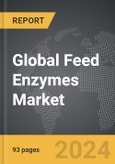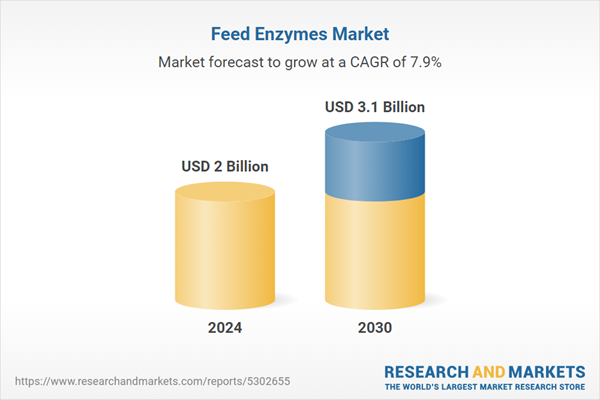Global Feed Enzymes Market - Key Trends & Drivers Summarized
What Is Driving the Demand for Feed Enzymes in Animal Nutrition?
The demand for feed enzymes is increasing due to their ability to enhance nutrient digestibility, improve animal growth rates, and optimize feed efficiency, all of which are essential for meeting the rising global demand for animal protein. Feed enzymes such as phytase, protease, and carbohydrase break down indigestible components in animal feed, enabling livestock to better absorb nutrients like phosphorus, protein, and energy. This not only improves the nutritional quality of the feed but also reduces the amount of feed required, which directly impacts production costs. As feed costs continue to rise globally, producers are increasingly adopting feed enzymes to maximize nutrient utilization, lower feed expenses, and increase profitability.Additionally, enzymes in animal feed support gut health and reduce digestive stress, which is crucial in high-intensity farming environments where animals are more susceptible to health issues. By enhancing the digestibility of fiber, protein, and minerals, feed enzymes help prevent nutrient wastage and promote optimal growth performance, particularly in poultry, swine, and aquaculture sectors. This trend is especially strong in regions with large livestock populations, such as North America, Europe, and Asia-Pacific, where producers are focused on maximizing production efficiency to meet high consumer demand for meat, dairy, and eggs. The increased focus on productivity and cost-efficiency in animal farming is a primary driver for the feed enzymes market.
How Are Technological Advancements Impacting the Production and Application of Feed Enzymes?
Technological advancements in biotechnology and enzyme production are transforming the feed enzymes market by enhancing enzyme efficacy, stability, and specificity. Innovations in microbial fermentation and genetic engineering have made it possible to produce more efficient enzymes at lower costs, making them accessible to a broader range of producers. These advancements enable the production of highly stable enzymes that can withstand the harsh conditions of animal digestive systems, ensuring optimal performance even at low inclusion rates. For example, heat-stable phytase can survive high temperatures during feed processing, maintaining its efficacy in breaking down phytates and increasing phosphorus availability for animals.Additionally, advances in enzyme encapsulation and slow-release technology have improved the targeted delivery of enzymes within the digestive tract, maximizing nutrient absorption and enhancing overall feed conversion efficiency. Precision enzyme formulations are also being developed to cater to specific livestock species and diets, allowing for customized enzyme combinations that address particular nutritional needs and feed components. Data-driven precision feeding techniques allow for real-time monitoring of enzyme performance, ensuring animals receive the right balance for their growth stage. These technological developments are making feed enzymes a crucial tool for maximizing feed efficiency, reducing nutrient waste, and supporting cost-effective animal production.
What Role Do Health Trends and Environmental Concerns Play in Shaping the Feed Enzymes Market?
Health trends and environmental concerns are increasingly shaping the feed enzymes market, as producers seek ways to improve animal welfare, reduce pollution, and support sustainable livestock production. Feed enzymes contribute to a healthier gut environment, improving nutrient absorption and minimizing undigested feed that can lead to digestive issues. By optimizing gut health, feed enzymes reduce the need for antibiotics, aligning with consumer demand for antibiotic-free animal products. The focus on gut health and natural growth promotion is particularly relevant in markets where consumers and regulatory bodies prioritize animal welfare and sustainable farming practices.Moreover, feed enzymes help reduce environmental impact by decreasing nutrient waste, specifically nitrogen and phosphorus excretion, which can contribute to soil and water pollution. Phytase, for example, reduces the need for supplemental phosphorus by releasing naturally occurring phosphorus from plant materials in feed, minimizing nutrient runoff and environmental contamination. This aligns with environmental regulations aimed at reducing agricultural emissions and pollution. As environmental standards become stricter, the adoption of feed enzymes is expected to grow, as they enable livestock producers to maintain high productivity while addressing sustainability and regulatory requirements. The increasing emphasis on both animal health and environmental stewardship is a key factor driving the demand for feed enzymes.
What Factors Are Driving Growth in the Feed Enzymes Market?
The growth of the feed enzymes market is driven by rising feed costs, the need for efficient nutrient utilization, advances in enzyme technology, and a growing focus on environmental sustainability. As feed prices continue to rise, livestock producers are adopting feed enzymes to maximize nutrient absorption, reduce feed costs, and increase profitability. The increasing demand for high-quality animal protein, coupled with advancements in enzyme production, has made it possible to create specific enzyme formulations that cater to diverse livestock species and feed types. Precision feeding solutions that incorporate enzymes tailored for specific diets have expanded the market's scope, allowing producers to achieve more efficient and sustainable production.Environmental and regulatory pressures are also boosting the market, as feed enzymes help reduce nutrient excretion and minimize the environmental footprint of animal agriculture. With strict environmental regulations in place, particularly in North America and Europe, producers are seeking ways to meet standards while maintaining productivity, making enzymes a valuable tool in eco-friendly farming practices. Additionally, consumer preferences for sustainable and antibiotic-free animal products support the use of feed enzymes as they improve animal health without the need for growth-promoting antibiotics. This convergence of economic, technological, and environmental factors is propelling the feed enzymes market forward, positioning it as a key component in modern, sustainable animal nutrition.
Report Scope
The report analyzes the Feed Enzymes market, presented in terms of market value (US$ Thousand). The analysis covers the key segments and geographic regions outlined below.- Segments: Type (Phytases, Carbohydrases, Proteases, Other Types); Application (Poultry, Pigs, Ruminant, Aqua, Pets, Equine).
- Geographic Regions/Countries:World; United States; Canada; Japan; China; Europe (France; Germany; Italy; United Kingdom; Spain; Russia; and Rest of Europe); Asia-Pacific (Australia; India; South Korea; and Rest of Asia-Pacific); Latin America (Argentina; Brazil; Mexico; and Rest of Latin America); Middle East (Iran; Israel; Saudi Arabia; United Arab Emirates; and Rest of Middle East); and Africa.
Key Insights:
- Market Growth: Understand the significant growth trajectory of the Phytases segment, which is expected to reach US$2.5 Billion by 2030 with a CAGR of a 7.9%. The Carbohydrases segment is also set to grow at 8.3% CAGR over the analysis period.
Why You Should Buy This Report:
- Detailed Market Analysis: Access a thorough analysis of the Global Feed Enzymes Market, covering all major geographic regions and market segments.
- Competitive Insights: Get an overview of the competitive landscape, including the market presence of major players across different geographies.
- Future Trends and Drivers: Understand the key trends and drivers shaping the future of the Global Feed Enzymes Market.
- Actionable Insights: Benefit from actionable insights that can help you identify new revenue opportunities and make strategic business decisions.
Key Questions Answered:
- How is the Global Feed Enzymes Market expected to evolve by 2030?
- What are the main drivers and restraints affecting the market?
- Which market segments will grow the most over the forecast period?
- How will market shares for different regions and segments change by 2030?
- Who are the leading players in the market, and what are their prospects?
Report Features:
- Comprehensive Market Data: Independent analysis of annual sales and market forecasts in US$ Million from 2024 to 2030.
- In-Depth Regional Analysis: Detailed insights into key markets, including the U.S., China, Japan, Canada, Europe, Asia-Pacific, Latin America, Middle East, and Africa.
- Company Profiles: Coverage of players such as ADM, Advanced Enzyme Technologies, Alltech, Amorvet, Associated British Foods Plc and more.
- Complimentary Updates: Receive free report updates for one year to keep you informed of the latest market developments.
Some of the 42 companies featured in this Feed Enzymes market report include:
- ADM
- Advanced Enzyme Technologies
- Alltech
- Amorvet
- Associated British Foods Plc
- Aum Enzymes
- Azelis Holdings SA
- BASF SE
- Bec Feed Solutions
- Bio Cat
- Bioproton Pty Ltd.
- Bioresource International Inc.
- Biovet Jsc
- Bluestar Adisseo
- Caprienzymes
- Cargill
- Dupont
- Karyotica Biologicals Pvt. Ltd.
- Kemin Industries, Inc.
- Koninklijke Dsm N.V
- Novozymes
- Novus International Inc.
- Nutrex BE
- Rossari Biotech Ltd.
- Sunson Industry Group Co. Ltd.
This edition integrates the latest global trade and economic shifts into comprehensive market analysis. Key updates include:
- Tariff and Trade Impact: Insights into global tariff negotiations across 180+ countries, with analysis of supply chain turbulence, sourcing disruptions, and geographic realignment. Special focus on 2025 as a pivotal year for trade tensions, including updated perspectives on the Trump-era tariffs.
- Adjusted Forecasts and Analytics: Revised global and regional market forecasts through 2030, incorporating tariff effects, economic uncertainty, and structural changes in globalization. Includes historical analysis from 2015 to 2023.
- Strategic Market Dynamics: Evaluation of revised market prospects, regional outlooks, and key economic indicators such as population and urbanization trends.
- Innovation & Technology Trends: Latest developments in product and process innovation, emerging technologies, and key industry drivers shaping the competitive landscape.
- Competitive Intelligence: Updated global market share estimates for 2025, competitive positioning of major players (Strong/Active/Niche/Trivial), and refined focus on leading global brands and core players.
- Expert Insight & Commentary: Strategic analysis from economists, trade experts, and domain specialists to contextualize market shifts and identify emerging opportunities.
Table of Contents
Companies Mentioned (Partial List)
A selection of companies mentioned in this report includes, but is not limited to:
- ADM
- Advanced Enzyme Technologies
- Alltech
- Amorvet
- Associated British Foods Plc
- Aum Enzymes
- Azelis Holdings SA
- BASF SE
- Bec Feed Solutions
- Bio Cat
- Bioproton Pty Ltd.
- Bioresource International Inc.
- Biovet Jsc
- Bluestar Adisseo
- Caprienzymes
- Cargill
- Dupont
- Karyotica Biologicals Pvt. Ltd.
- Kemin Industries, Inc.
- Koninklijke Dsm N.V
- Novozymes
- Novus International Inc.
- Nutrex BE
- Rossari Biotech Ltd.
- Sunson Industry Group Co. Ltd.
Table Information
| Report Attribute | Details |
|---|---|
| No. of Pages | 291 |
| Published | December 2025 |
| Forecast Period | 2024 - 2030 |
| Estimated Market Value ( USD | $ 2 Billion |
| Forecasted Market Value ( USD | $ 3.1 Billion |
| Compound Annual Growth Rate | 7.9% |
| Regions Covered | Global |









